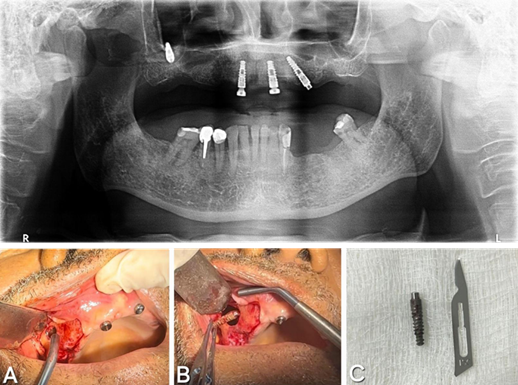Removal of a Dental Implant Displaced into the Maxillary Sinus Following All-on-Four Protocol: A Case Report
Main Article Content
Abstract
Oral rehabilitation with dental implants has emerged as an effective alternative for patients with edentulism, offering improvements in masticatory function, aesthetics, and quality of life. The All-on-Four protocol is widely used for full-arch rehabilitation, employing four strategically positioned implants to support fixed prostheses while minimizing the need for bone grafts. However, complications can occur, especially in regions with unfavorable anatomical characteristics, such as the posterior maxilla, where low bone density and maxillary sinus pneumatization increase the risks. This article reports a clinical case of a 74-year-old male patient, without comorbidities, who presented with displacement of a dental implant into the right maxillary sinus, 30 days after the All-on-Four procedure. The displacement was confirmed by panoramic radiography. Surgical removal was planned using the Caldwell-Luc technique, performed under local anesthesia in an outpatient setting. After mucoperiosteal incision and flap elevation, an elliptical osteotomy was performed on the anterior wall of the maxillary sinus. The initial attempt to remove the implant by aspiration was unsuccessful, requiring enlargement of the bone window and the use of a Dietrich forceps for successful removal. Following extraction, a new implant was installed, and the maxillary sinus was obliterated. The procedure was successful, without complications, and the patient received appropriate postoperative instructions. The Caldwell-Luc technique proved to be effective and safe for the removal of displaced implants. This case highlights the importance of meticulous surgical planning, careful analysis of the maxillary anatomy, and adequate postoperative follow-up to prevent complications and ensure the success of oral rehabilitation with dental implants.
